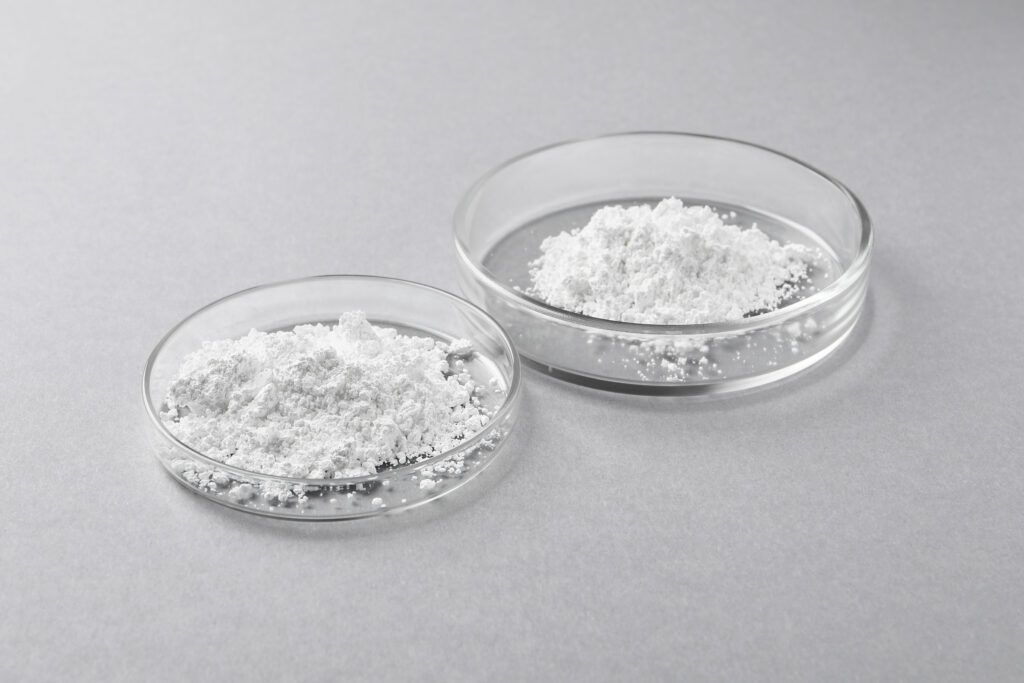From waste to valuable products
Ultra-pure calcium carbonate
Of the materials produced from ash, the biggest focus is on ultra-pure calcium carbonate, which can be used, for example, in the food and pharmaceutical sectors. However, since the waste material we are valorising comes from industry , it is most likely that calcium carbonate produced from oil shale ash in Ida-Viru county will be used in paint, plastic and paper industries.
The unique technology allows us to adapt the size and shape of calcium carbonate molecules to meet the high requirements of various uses. It is also significant that our product is produced in a climate-neutral way, which is achieved through emission-free production and additional CO2 capture into the product. Normally, calcium carbonate is produced by mining and using a combustion process, which results in a product with a large environmental footprint.

Lime fertilizer for farmers
Lime is a by-product which helps improve soil conditions by addingmicroelements essential for plant growth. Since lime is recovered from oil shale ash as a secondary material and not produced from entirely new raw materials, it is once again a more environmentally friendly product than its alternatives.
Fillers for the manufacturing industry
Another by-product in the oil shale ash upcycling is a material with a high content of silicates and can be used, for example, as backfilling material in the construction sector. Ragn-Sells Group is developing the most appropriate usage for this material, which will ultimatelybe re-recycled.
Future products
Oil shale ash is also a remarkable source of many other critical elements. The stocks of such elements are constantly decreasing, so their recovery from oil shale ash is not only an environmentally friendly alternative, but also a practical strategy in the search for new mineral deposits. In the OSA project, we will explore ways to recover the following elements from oil shale ash:
Mg
Magnesium
Al
Aluminium
Fe
Iron
Zn
Zinc
Si
Silicon

What is calcium carbonate?
Professor Andres Trikkel from the Department of Materials and Environmental Technology at TalTech School of Engineering:
Calcium carbonate (CaCO3) is the main component of natural limestone. As a mineral, it is known under the name calcite, but also as aragonite or vaterite depending on the differences in the crystal structure. However, the latter two are not very common. Limestone contains at least 50% calcium carbonate. Limestone also contains magnesium carbonate and other minor constituents. The carbonate rock with the highest magnesium content is known as dolomitic rock (dolomite as a mineral). The main component of dolomite is the compound CaCO3×MgCO3. Chalk is the soft and porous form of limestone and the decorative material marble has also formed from limestone or dolomite. Estonian dolomite has often been used as a finishing material (façade and decorative tiles, windowsills, kitchen worktops), and in limestone buildings (houses in the Old Town, burial mounds, walls, churches, manor houses) which can be seen everywhere in Estonia. The steep limestone cliffs on the Northern coastline are formed mainly of limestone.
Synthetic vs. organic calcium carbonate?
Andres Trikkel: The difference between natural and synthetic calcium carbonate lies in the content of minor constituents. Minor constituents may comprise up to 25% of natural limestone, which affect the colour, strength and other qualities of the amaterial. Based on these properties, limestone is categorised into construction limestone and technological limestone. The first, as the name suggests, is used for construction and as crushed stone, the other is used for the production of cement and lime. Pure limestone is rarely found in the nature. The purest of the samples found in Estonia among those kept in the laboratory of Tallinn University of Technology is Vasalemma ‘marble’ (95.6-97.4% CaCO3, 0,84-1,46% MgCO3residue insoluble in hydrochloric acid that characterises a minor constituent content of 0.45-0.76%). High purity limestone should contain more than 97% CaCO3.
Why and where is calcium carbonate used?
Andres Trikkel: Minor constituent content is limited and minimised in synthetic calcium carbonate. Depending on the use (paper, paint, plastic, food and pharmaceutical industries, where limestone is a filler, as well as cement, glass and ceramic materials industries), calcium carbonate of certain qualities is needed. The content of minor constituents such as iron, magnesium, sulphur and other compounds is limited and, depending on use, limits have also been established for the shape, size or colour of the particles of the material. This is achieved by the relevant chemical and technological methods. In Estonia, the Rakke limestone plant of Nordkalk AS offers various limestone products.